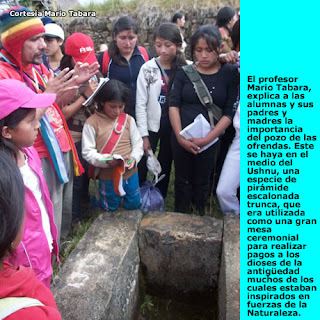Inti Raymi in Aypate
The Sun’s festivity at the sacred place of the ancestors.
AYABACA, Peru – Into the Andean cosmovision, there were ceremonies that were ever linked to the astronomical movements, especially the Sun, for the one they granted two festivities – Inti Raymi (June 21st, solstice of austral winter)and Kápaq Raymi (December 21st, solstice of austral summer). Those two festivities mark the activities of agriculture and cattle in the Andean world.
Purposed
to save the cultural identity, on June 24th, 2010, the students of 2nd
grade A, B, and C of Ayabaca’s Señor Cautivo
School,
with their teachers and parents, homage this date when the Sun gets further
from the South Hemisphere, beginning the winter solstice.
The
morning was cool, the tractor, that worked on the rehabilitation of the road,
just arrived to Aypate [pronounce Aypatéh].
A shower had the castand the attendants became dismotivating. When the ceremony
began, that started with a pagapu (a
gift to the protector spirit)by the Master Gerardo Avendaño Pozo, who drank sugarcane primera (first
distillation)and tobacco, offering it lotions, the sky cleared, and Inti Tayta (Father Sun) shined.
After the guided visit through the Aypate administrative and ceremonial centerby its kayanka (a kind of shed), acllawasi [akjawasi ] (house of virgins), and ushnu [ooshnu] (ceremonial stage), the rehearsed plays were performed for this homage.
The
first one was Aypa Atik (The one reaching
the highest), that is the recreation of the Aypate’s legend in the
beginning of Ayawaka culture, performed by the students of 2nd C,
which Aypate is someone linked to Nature, and who, because
of his wise proceeding, is deserved to engage Pacha Sonqo (Earth’s Heart), the daughter of the old governor who,
looking at her in the age to be married, calls for a tournament wwhich an
unwounded deer has to be brought.
After
many bachelors presented with their deers, no one brough an untouched one until
Aypate appears with his deer that walked through the place, so he’s chosen as
the inheritor to govern the Ayawaka people.
The
second play was The Resistance of the
Wayakuntu, confederation joined by ayawakas,
calvas, and caxas facing the Incas, whoafter fighting “five moons,” as Garcialaso
de la Vega tells on his Royal Commentaries of the Incas, the last Ayawakas
conciliate with the Incas and the building of Aypate administrative
and ceremonial center begins.
The third one was Ollantay [Oyantay], known play written amid the Colony, and tells us the courage of this character who rebels the Antisuyo [Anteesooyo] due to the rejection of Pachacutec [Pachacoottec]to engage him to Cusi Coyllur [Koosi Koiyoor], until a complaint by Ima Sumac, Túpac Yupanqui [Tupac Yupanki] forgives Ollantay and marries Cusi Coyllur.
The
three plays ended with related dances, that was one of the activities performed
in every milestone of Tawantinsuyo [Tawantinsooyo], the Inca nation. That is
how the students of Señor Cautivo School worked with their teachers and parents
onto the rescue of the ancestral cultural identity and achieving touristic
awareness.
They
manifested: “The Aypate administrative and ceremonial center is wonderful
because we knew the greatness of our ancestors, we also knew how the Incas have
sculpted the rockfor their buildings, and we thank the teacher who has carried
us to this archaeological and touristic place that continues permanent up to
today, and for let us to know the greatness of Incas.”
Check out more stories
we posted about Aypate.






Comentarios
Publicar un comentario